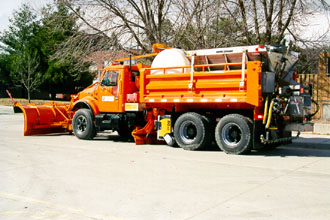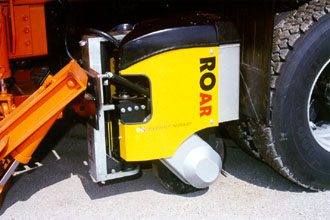U.S. Department of Transportation
Federal Highway Administration
1200 New Jersey Avenue, SE
Washington, DC 20590
202-366-4000
Focus
| Accelerating Infrastructure Innovations |
Publication Number: FHWA-SA-98-026
Date: October 1998

For the Iowa, Michigan, and Minnesota departments of transportation (DOT), winter maintenance has gone state-of-the-art. In 1995, the three States formed a consortium, supported by the Center for Transportation Research and Education at Iowa State University and the Federal Highway Administration, to design and develop an advanced winter maintenance truck. Three years later, this design is now a reality and the prototype vehicles are hitting the roads in each State to take on the challenges of snow and ice. While the trucks are proving to be moving laboratories, evaluating the effectiveness of new technologies, they are also already important additions to the States' maintenance fleets.
The idea for the advanced winter maintenance vehicle came to Lee Smithson, deputy director of the maintenance division at the Iowa DOT, as he was on a 1994 trip to Japan. Looking at the high-tech winter maintenance trucks developed in Japan, "I was just amazed," says Smithson. "I came back and said 'we need to do something like this.'"
Minnesota and Michigan quickly signed on to the design effort. After gathering information on up-to-the-minute snow and ice control technologies that could be applied to the prototype vehicle, the three States then each conducted focus groups to help determine the vehicle's design. Focus group participants included DOT equipment operators, mechanics, and maintenance managers and supervisors, as well as representatives from other organizations with an interest in the new vehicle, including law enforcement and emergency response personnel.
"The focus groups were the best things that we ever did," says Smithson. "One of the reasons that this project has been so successful is that we involved mechanics and drivers from the beginning, and they have been very supportive."
Private industry has also been supportive. The consortium hosted a workshop in 1996 to introduce the project to vehicle manufacturers, communications and technology firms, and equipment vendors. Many subsequently became partners in the research effort, including Rockwell International, Navistar, Norsemeter, and Global Sensor Systems.
A prototype vehicle was assembled for each of the consortium States by March 1997, using trucks already purchased as part of the States' fleets. Each vehicle is a standard tandem axle truck with a 22,680 kg (50,000-lb) gross vehicle weight. Iowa and Minnesota's trucks have dump boxes, while the Michigan truck has a chassis-mounted material spreader and brine tank. All three trucks have front, wing, and underbody plows.
The trucks' features include a global positioning system (GPS) receiver that determines the location of the vehicle every 5 seconds. This data is recorded by a new on-board system, known as Plowmaster, that was developed by Rockwell especially for the prototype vehicle. The trucks are also equipped with newly designed liquid and granular spreading equipment that can dispense dry, prewetted, or liquid materials for deicing or anticing operations. Other features include a hydrous-ethanol injection system, which automatically injects an ethanol fuel whenever an engine power boost is needed; fiber-optic lighting that provides more visibility during storms and whiteout conditions; and a custom-designed friction measuring device that measures and records the friction of the road surface. This device signals the driver and the on-board computer when more chemicals need to be applied to prevent the pavement from becoming slippery.
Each vehicle also has a Road Watch Warning System, which monitors the air and pavement surface temperature, and a Search-Eye Sensor System, which detects the presence of any vehicles or obstructions behind the truck and automatically applies the brakes if necessary when the truck is put into reverse.
In addition to recording GPS data, the Plowmaster collects data from the trucks' pavement surface and air temperature sensors, friction meter, and material applicator, as well as selected engine information. The States hope to soon be able to transmit this data directly to computers at maintenance garages and traffic operations centers in order to better coordinate operations and improve weather advisory information available to travelers.
The trucks received their first full tryout last winter and "performed pretty well," says Smithson. "Operators experienced hardly any breakdowns in technology at all." Although many of the trucks' features had not been used in tandem before, the technologies have proven to be very compatible.
One problem that did arise with the Michigan and Minnesota vehicles was with the friction measuring device. Michigan did not have the room to mount the device on its truck, and Minnesota had to mount it at the rear of the truck, which was not a desirable location because of splashing snow and chemicals. To fix these problems, the manufacturer is currently redesigning the friction measuring device and expects to have the new version ready this fall.
Iowa, Michigan, and Minnesota are now working on building a second-generation vehicle for use next winter. The new vehicle will include a device that measures the salt brine concentration on the road, providing the DOTs with a record of the materials applied.
As Iowa, Michigan, and Minnesota prepare to roll out the second-generation trucks, they are also working to recruit other States to the consortium effort. "We need to get more States on board," says Smithson.
John Scharffbillig of Minnesota DOT emphasizes that while other States may not need all of the technologies on the prototype truck, "they can take this piece of it or that piece of it and integrate it into their operations. There's something for everyone."
Following testing of the second-generation trucks, the States will decide whether to proceed to the final phase of the project, which would involve assembling 10 of the advanced concept vehicles for each of the State in the consortium.
For more information, contact Lee Smithson at Iowa DOT, 515-239-1519 (fax: 515-239-1005; email: lsmiths@iadot.e-mail.com), or John Scharffbillig at Minnesota DOT, 651-582-1000 (fax: 651-628-6796; email: john.scharffbillig@dot.state.mn.us).

The advanced winter maintenance truck now being used by Iowa, Michigan, and Minnesota features such state-of-the-art equipment as fiber-optic lighting and a custom-designed friction measuring device.